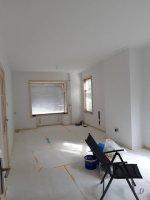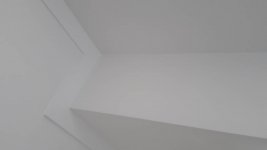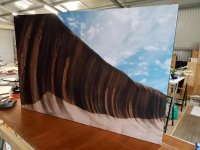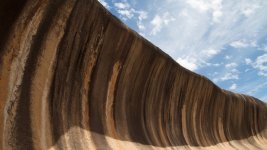Looking great.
Update on my end. I read through the article linked. It's an excellent paper. However, I can't make the mental leap from the frequency response measurements described in the paper to the type of plot shown in post #6235. More reading to do.
Update on my end. I read through the article linked. It's an excellent paper. However, I can't make the mental leap from the frequency response measurements described in the paper to the type of plot shown in post #6235. More reading to do.
This graph is a Vituix prediction of on axis (grey) in room (orange) and power response (blue).
The on axis response is what you generally take with nearfield measurements, to include directivity and baffle effects to lower frequencies the measurement distance needs to be longer, which can then become problematic to avoid reflections.
The in room response in the graph includes simulated reflections and that particular comparison is showing how the response of a single driver is more impacted by those reflections than a simulated array is.
The predicted in room response sometimes called PIR is usually a very good match to the early reflections curve from spinorama CEA-2034 measurements.
The power response is a combination of the on axis and off axis responses combined and for most speakers the power response will fall with frequency. Peaks and dips in the power response indicate issues in the off axis response.
The two bottom traces are the directivity indexes, standard and early reflections. A flat DI represents Constant Directivity. The response is the same at all angles. A rising DI like is shown there is typical of most speakers and shows that the speaker becomes more forward directive as frequency rises.
I would recommend getting a copy of Sound Reproduction by Floyd Toole, not a cheap book but well worth the price particularly the third edition. The internet will provide electronic versions if you look hard enough though 🙄
Good video from Floyd Toole here
Floyd Toole - Sound reproduction – art and science/opinions and facts - YouTube
or this
Objective Loudspeaker Measurements to Predict Subjective Preferences? | Audioholics
This article might give you some pointers as well
https://www.sausalitoaudio.com/wp-content/uploads/2018/07/Interpreting-Spinorama-Charts.pdf
Thank you so much, fluid, for both the links to resources and the explanations. Truly appreciated. 
Please correct me if I am wrong. Based on the context of what wesayso was looking to potentially confirm from the simulation, your explanation above, and the Bagly paper, would it be helpful to:
a) take a near-field measurement of a frequency sweep with the microphone within a few inches (based on the calculations in the paper using the radius of only one driver) of the center driver in the array; the tweeter; AND
b) take a near field measurement (but I'm still not sure if it would qualify as near field) based on using the cumulative area / radii of all 6 upper mid drivers in the uppper mid-range array and/or use the calculation for all 7 drivers?
Since the radius of the drivers along with the size of the baffle seem to factor quite a bit into how to properly measure; I can't seem to wrap my head around what may be most meaningful to help determine if the "real world" agrees with the simulation. I don't mind taking the time at all. I messed with it for hours just to try and wrap my head around it. However, I would hate to mislead anyone with an improperly obtained measurement.

Please correct me if I am wrong. Based on the context of what wesayso was looking to potentially confirm from the simulation, your explanation above, and the Bagly paper, would it be helpful to:
a) take a near-field measurement of a frequency sweep with the microphone within a few inches (based on the calculations in the paper using the radius of only one driver) of the center driver in the array; the tweeter; AND
b) take a near field measurement (but I'm still not sure if it would qualify as near field) based on using the cumulative area / radii of all 6 upper mid drivers in the uppper mid-range array and/or use the calculation for all 7 drivers?
Since the radius of the drivers along with the size of the baffle seem to factor quite a bit into how to properly measure; I can't seem to wrap my head around what may be most meaningful to help determine if the "real world" agrees with the simulation. I don't mind taking the time at all. I messed with it for hours just to try and wrap my head around it. However, I would hate to mislead anyone with an improperly obtained measurement.
A nearfield measurement on an array can only be of use in checking the functioning of that particular element, i.e. to see if it is working at all or if there is gross distortion etc.
The array effects will not begin to form until further out from the drivers where they begin to combine as designed.
Ideally you would take the measurement at 2m in as reflection free environment as you can. That is easier said than done.
1m might well be far enough out to see the array and baffle effects as I imagine they operate somewhere from 1.5K upwards.
So in terms of the white paper it would be the size of the overall tweeter array.
To make a really useful measurement that will show what the array is doing you would need to take polar measurements horizontally and vertically at regular angles, the finer the angular resolution the better. They can be used in Vituixcad and show the full polar plot and off axis angles. Reading the help file for Vituix would probably be worth doing to understand what is needed.
This is not usually where people start there measurement journey though which is why I suggested the Bagby paper as a primer. What you want to do is up at the difficult end of the scale 🙂
Using a turntable properly to make the angular measurements and getting a reflection free window of sufficient time can take some working out.
The array effects will not begin to form until further out from the drivers where they begin to combine as designed.
Ideally you would take the measurement at 2m in as reflection free environment as you can. That is easier said than done.
1m might well be far enough out to see the array and baffle effects as I imagine they operate somewhere from 1.5K upwards.
So in terms of the white paper it would be the size of the overall tweeter array.
To make a really useful measurement that will show what the array is doing you would need to take polar measurements horizontally and vertically at regular angles, the finer the angular resolution the better. They can be used in Vituixcad and show the full polar plot and off axis angles. Reading the help file for Vituix would probably be worth doing to understand what is needed.
This is not usually where people start there measurement journey though which is why I suggested the Bagby paper as a primer. What you want to do is up at the difficult end of the scale 🙂
Using a turntable properly to make the angular measurements and getting a reflection free window of sufficient time can take some working out.
AHA! Some additional reading re: Vituix will definitely be required for me to understand the meaning and relative importance of the measurements nevertheless how to execute them properly.
Maybe it's the morning brain fog and only having only had one cup of coffee, but just reviewing the opening page, a few YouTube videos, and perhaps only 5% of the manual itself left me with the nightmare image of walking naked into an oral exam at uni.
What I can easily say is that Kimmo Saunista is now added to my list of incredibly generous people in this hobby that provide "pro-level" tools for the hobbyist at little to no cost. Wow, just wow!
Yes, you're correct. This may be WELL above my ability level (for now). I had no idea what I was getting into. In for a penny, in for a pound. I have some time on my hands to continue to learn. An old dog may pick up a new trick; who knows? I'm generally pretty tenacious once I'm "on the scent".
I haven't had a turntable for years, and although many are encouraging me to get back into vinyl; if I do, it could surely end in my demise. My wife would beat me with a wet noodle.
Back to just listening to a few tunes and more reading. Many thanks!
Maybe it's the morning brain fog and only having only had one cup of coffee, but just reviewing the opening page, a few YouTube videos, and perhaps only 5% of the manual itself left me with the nightmare image of walking naked into an oral exam at uni.
What I can easily say is that Kimmo Saunista is now added to my list of incredibly generous people in this hobby that provide "pro-level" tools for the hobbyist at little to no cost. Wow, just wow!

Yes, you're correct. This may be WELL above my ability level (for now). I had no idea what I was getting into. In for a penny, in for a pound. I have some time on my hands to continue to learn. An old dog may pick up a new trick; who knows? I'm generally pretty tenacious once I'm "on the scent".
I haven't had a turntable for years, and although many are encouraging me to get back into vinyl; if I do, it could surely end in my demise. My wife would beat me with a wet noodle.

Back to just listening to a few tunes and more reading. Many thanks!
I've done modelling of absorbers faced with a light, thin flexible membrane and they work well at LF and even MF, depending on what the membrane really is. Do you have any idea where the absorption starts falling off due to the posters?
Even though we're building up again we still have a long way to go. After the walls an ceiling are all done we'll start restoring our window sills, trying to recapture the original look of the 20's build style.
I believe its going to look great but it takes up a lot of time.
I got a request to change my damping panel/poster of Led Zeppelin. We're thinking of 3 smaller portrait posters side by side.
One of them could be this one:
View attachment 870710
Still looking to find two similar styled posters from Led Zep, The Doors or Pink Floyd etc. Open to suggestions...
Picture does not show up.....
Picture does not show up.....
See below its fine here in my browser for post 6295, well except those nice looking line arrays is not proudly standing in there anymore 😛..
Attachments
Last edited:
That's not the one Perceval is referring to. In Wesaysos last post about the damping posters the attachment is invalid when you click on it. Happens sometimes when you edit a post.
yep, thanks Byrtt, but, yes, I was referring to the new portrait poster dampening panel picture.
That's not the one Perceval is referring to. In Wesaysos last post about the damping posters the attachment is invalid when you click on it. Happens sometimes when you edit a post.
Right picture for poster or whatever is missing there 🙂..yep, thanks Byrtt, but, yes, I was referring to the new portrait poster dampening panel picture.
So, Bowie.
Alright... you guys are aiming at this kind of heavily artsy coloured portrait?
B/W ok or just colours?
And portrait of people or stage pictures ok?
Only 3 would probably be easy for me... I'd just put Geddy, Alex and Neil.... 😉
Alright... you guys are aiming at this kind of heavily artsy coloured portrait?
B/W ok or just colours?
And portrait of people or stage pictures ok?
Only 3 would probably be easy for me... I'd just put Geddy, Alex and Neil.... 😉
Last edited:
Printed on Kona cotton black and white was less appealing. I still have a b/w version of the Zep poster that wasn't as great looking as the color version we had hanging.
The Kona cotton is very transparent even for high frequencies.
The Kona cotton is very transparent even for high frequencies.
The Kona cotton wasn't available when I ordered the print for my panel and I don't see it on there now. I ordered the Silky Faille but I think the finish would be different to what you had before.
right off the bat, here are a few I would consider myself....
I'm sure more will pop in my mind later
🙂
I'm sure more will pop in my mind later
🙂
Attachments
Thank you, perceval, I've been hunting for suitable pictures and came across one very similar SRV picture.
@fluid I see... Kona cotton did disappear!
Wondering what would be comparable here. If it were up to me I'd put up the Zep poster again bit after 18 years of Zep on the wall, maybe it is time for a change.
I've been thinking about movie posters as well.
Still lots to do to finish up, so no hurry yet. This is how it looks right now:
@fluid I see... Kona cotton did disappear!
Wondering what would be comparable here. If it were up to me I'd put up the Zep poster again bit after 18 years of Zep on the wall, maybe it is time for a change.
I've been thinking about movie posters as well.
Still lots to do to finish up, so no hurry yet. This is how it looks right now:

@fluid I see... Kona cotton did disappear!
Wondering what would be comparable here.
I chose the Silky Faille as a number of other people had used it without complaint when I did a search.
Attached is what it came out like vs original image for a refresher. The Fabric itself has a bit of a one way stretch to it so alignment can be a bit of a pain, but I imagine you experienced that before anyway 🙂
I've also destroyed and rebuilt my own room in the last few weeks, not quite as far as you as the ceiling stayed in (except for the the hole where the fireplace flue used to be)🙂
Attachments
Thank you, perceval, I've been hunting for suitable pictures and came across one very similar SRV picture.
@fluid I see... Kona cotton did disappear!
Wondering what would be comparable here. If it were up to me I'd put up the Zep poster again bit after 18 years of Zep on the wall, maybe it is time for a change.
I've been thinking about movie posters as well.
Still lots to do to finish up, so no hurry yet. This is how it looks right now:
Movie poster?
I think this one is appropriate! 😀

- Home
- Loudspeakers
- Full Range
- The making of: The Two Towers (a 25 driver Full Range line array)








